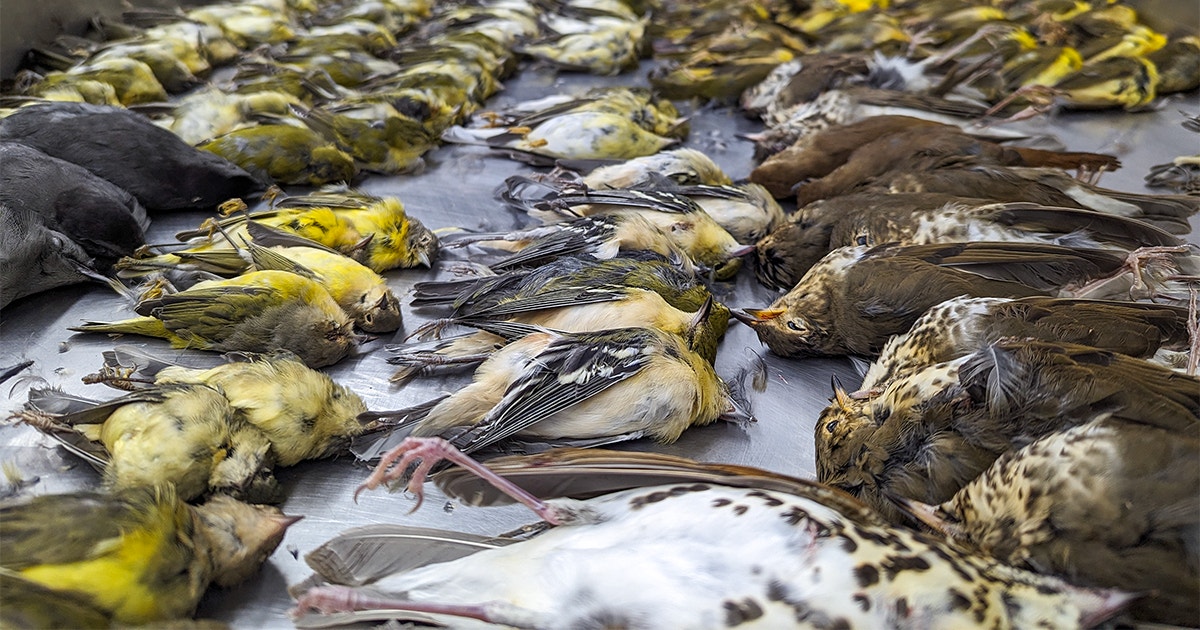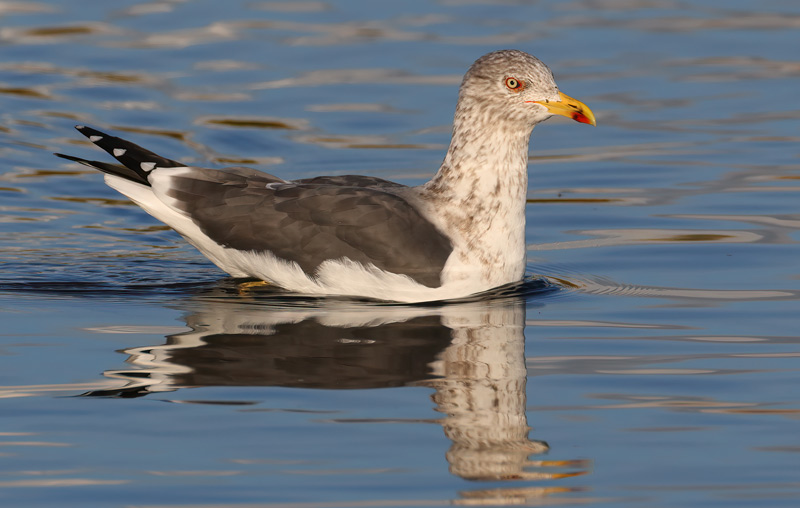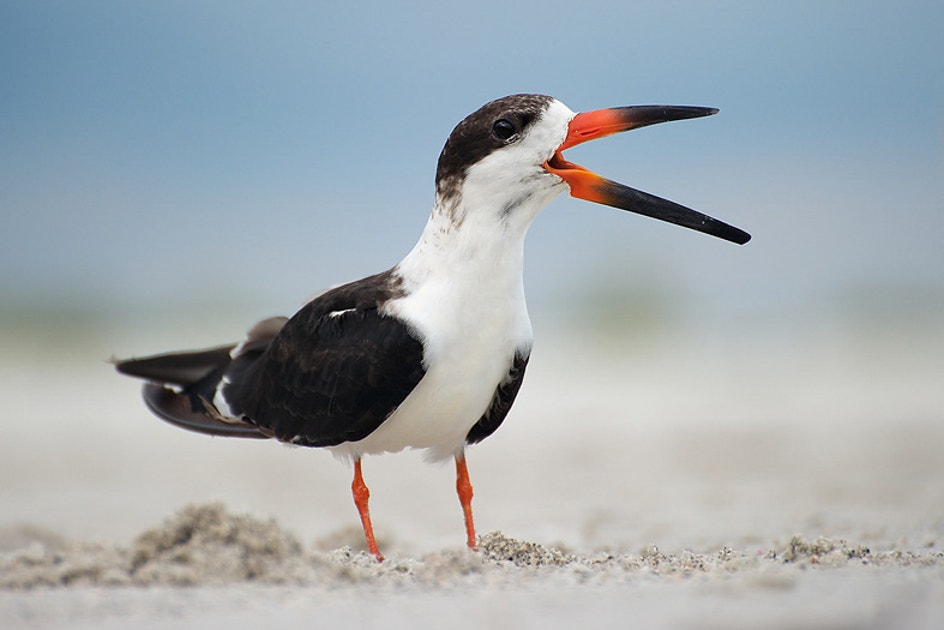As Dave Willard approached McCormick Place Lakeside Center, the Chicago convention center abutting Lake Michigan, in the wee hours of Thursday morning, he heard more calls of night-migrating birds than usual. But still, he didn’t know what he was in for. “I didn’t anticipate what I was going to see when I got up to the building,” says the collection manager emeritus in the Bird Division at Chicago’s Field Museum. Rapidly though, uncertainty gave way to shock and dismay at the scene that lay before him: hundreds and hundreds of dead and stunned birds.
Willard is one of a handful of Field Museum staff members who patrol McCormick Place every morning during bird migration season. The building is a notorious collision hotspot, “the worst documented in the city,” Willard says. And Chicago itself is one of the most dangerous cities for migrating birds. He’s been collecting bird strike victims from around the convention center for about 40 years and says the carnage he came across on the morning of October 5th was a record in his time monitoring the area. In total, Willard and his colleagues collected 964 dead birds, mostly warblers, along with an estimated 80 stunned live ones. It was “truly unprecedented,” he says. Before this week, the worst collision numbers he’d witnessed at McCormick place were around 200. This was death on a whole different scale.
“You pick up a Rose-breasted Grosbeak and realize, if it hadn’t been for a building in Chicago, it would be spending its winter in the foothills of the Andes,” Willard says. “It’s just a shame that a city can’t be less of an obstacle.”
The casualties weren’t confined to the convention center. Elsewhere in the city, high numbers of bird collisions were also documented. One volunteer with Chicago Bird Collision Monitors (CBCM) picked up 200 birds herself downtown, according to Willard. Another collected 50 more. In total, CBCM found around 450 deceased birds and 300 more injured ones—a record, Annette Prince, the organization director, told the Chicago Tribune. When Audubon called CBCM to confirm these numbers, Prince answered the phone but said she was fielding too many strike-related calls to respond to more questions.
All the building strikes occurred during a big pulse of migration activity, according to data from The Cornell Lab of Ornithology’s BirdCast. A narrow, diagonal band of high-intensity migration was forecast from Michigan’s Upper Peninsula to Texas and New Mexico on the night of October 4, with an estimated 679.4 million birds on the move nationwide. One eBird report from a single birder documented more than 135,000 individuals passing by a Chicago city park in the span of less than an hour on Thursday morning. Another estimated seeing more than 173,000 birds over the course of 3.5 hours. “Utter madness, one of the most incredible days of migration I’ve witnessed in Chicago,” the latter birder wrote in their description of the morning. In sum, an estimated million birds passed through Chicago Wednesday night, says Willard.
“Walking back to the museum from McCormick, I was aware of the astounding numbers of live Palm and Yellow-rumped Warblers around, but I was too tired to enjoy it,” Willard says.
Though the collision counts were unprecedented, the migration numbers weren’t, says Benjamin Van Doren, a migration researcher at the University of Illinois. Large waves of migrating birds are common throughout the fall and spring, he notes. In fact, even more birds were over Chicago on Thursday night than the night before (about 10 million over Cook County), but many fewer hit buildings, Van Doren says. “The important difference is that since the weather conditions had improved, birds did not pile up, fly at low altitudes, and try to land en masse in the region,” he explains.
Early Thursday morning an awesome, natural migration event combined with unfortunate weather and human infrastructure to yield tragedy. A storm before dawn forced migrants to fly lower in the sky, and many birds seem to have inadvertently crossed a sharp delineation between good flying weather and bad within the bounds of Chicago, according to BirdCast’s analysis. Couple that with disorienting, brightly lit buildings and the record number of deaths resulted. But it doesn’t have to be that way. Efforts like Audubon’s Lights Out program and Bird-Friendly Buildings initiative are making a big difference for birds and helping to prevent future avian catastrophe.
This morning as children waited to enter school in Chicago, birds fell dead at their feet. The culprit? Reflective glass windows. 15 dead birds were recovered from one school.
If you are interested in making your workplace bird-friendly, please call us: 773-988-1867. pic.twitter.com/gtlmkWUsgf
— Chicago Bird Collision Monitors (@BirdMonitors) October 5, 2023
When McCormick Place has its lights off or curtains closed, Willard notes that many fewer collisions occur. A 2021 study determined that halving the number of lighted windows on the lakeside building could cut fatal bird collisions by 60 percent. However, the convention center glowed along the waterfront on Wednesday night. The building’s threat to wildlife has been an ongoing conversation with building managers and the city, says Willard, and things are a little better than they used to be. But still, it seems those in charge aren’t consistently prioritizing birds.
Two years ago, Illinois passed the Bird Safe Buildings Act, but the law, which went into effect last year, only applies to new and renovated buildings owned by the state. Advocates agree that broader changes are needed to spare all the birds that could be saved.
It’s difficult to know if and how individual collision events like this lead to long-standing population impacts for the affected birds, says Willard. But added altogether, mass bird strikes add up. Each year, an estimated 1 billion birds die from building collisions, and some types of birds are harder hit than others—warblers included. It’s hard to imagine all those deaths, coupled with habitat loss and climate change, don’t hurt species over time, Willard adds.
While what happened between Wednesday evening and Thursday morning was a massive outlier incident, Willard collected more birds again this morning, after a night of clearer weather—about 60 more collision victims, this time more sparrows than warblers. “That would be a big night in a normal season, when you didn’t have a previous night of 900,” he says. Tonight again, BirdCast projects high intensity migration across much of the Midwest, a good reminder to keep your lights off and binoculars at the ready.



